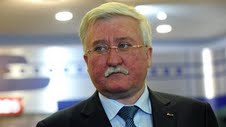
Iskander
How do you rattle your rockets? First get some rockets.
President Dmitriy Medvedev’s address last week underscored the extent to which Russian foreign and defense policies are hampered by the condition of the OPK and its shortage of production capacity.
Medvedev’s description of Russian steps in response to U.S. and NATO missile defense in Europe certainly didn’t surprise anyone, though it may have forced them to conclude the U.S.-Russian “reset” is wearing thin.
To refresh the memory, the first four were (1) put the Kaliningrad BMEW radar into service; (2) reinforce the defense of SYaS with VVKO; (3) equip strategic ballistic missile warheads with capabilities to overcome MD; and (4) develop measures to disrupt MD command and control.
Then fifth, repeating several previous assertions to this effect, Medvedev said:
“If the enumerated measures are insufficient, the Russian Federation will deploy in the country’s west and south modern strike weapons systems which guarantee the destruction of MD’s European component. One such step will be deployment of the ‘Iskander’ missile system in the Kaliningrad special region.”
And, ultimately, of course, Medvedev also noted the dispute over MD could lead Russia to withdraw from new START.
Russianforces.org was first to write that Medvedev’s enumerated steps represented nothing more militarily than what Moscow already intends to do, with or without U.S. missile defense in Europe.
Kommersant recalled the difficulty of making threats with the Iskanders:
“The problem is by virtue of its limited range (several hundred kilometers) ‘Iskander’ missiles can only threaten [Russia’s] neighboring states, but in no way the U.S. MD system as a whole, and on this plane, they have little influence on the strategic balance as such. Moreover, the Russian military has promised to begin deploying ‘Iskanders’ massively since 2007, but since then the deadlines for their delivery to the army has been postponed more than once. The army now has a single brigade of ‘Iskanders’ – the 26th Neman [Brigade], which is deployed near Luga. This is 12 launchers. There is also a 630th Independent Battalion in the Southern Military District. In GPV-2020, ten brigades more are promised.”
So, Iskander deployments, including probably in Kaliningrad, will happen anyway, regardless of MD, when Moscow is able to produce the missiles.
Interfaks-AVN quoted Ruslan Pukhov on the missile production capacity issue. If Russia wants to deploy Iskander in Kaliningrad or Belarus or Krasnodar Kray as a response to European MD, then:
“. . . it’s essential to build a new factory to produce these missiles since the factory in Votkinsk can’t handle an extra mission.”
“Productivity suffers because of the great ‘heterogeneity’ of missiles [Iskander, Bulava, Topol-M, Yars]. Therefore, if we want our response to MD on our borders to be done expeditiously, and not delayed, we need a new factory.”
Vesti FM also covered his remarks:
“’Iskander’ is produced at the Votkinsk plant. The ‘Bulava,’ and ‘Topol-M,’ and multi-headed ‘Yars,’ are also produced there. Therefore, such heterogeneity in missiles leads to the fact that they are produced at an extremely low tempo.”
The 500-km Iskander (SS-26 / STONE), always advertised with significant capabilities to defeat MD, was accepted in 2006. But the Russian Army didn’t complete formation of the Western MD Iskander brigade or Southern MD battalion until the middle of last month, according to ITAR-TASS. The army expects to get a full brigade of 12 launchers each year until 2020.
But Iskanders still aren’t rolling off the line like sausages. This spring Prime Minister Putin promised to double missile output, including from Votkinsk, starting in 2013, and pledged billions of rubles to support producers. In early 2010, Kommersant wrote about Votkinsk overloaded with orders, trying to modernize shops to produce Iskander.
Votkinsk and Iskander are, by the way, not the only defense-industrial problem relative to countering MD. Nezavisimaya gazeta pointed out VVKO will need lots of new S-400 and S-500 systems (and factories to produce them) to protect Russia’s SYaS. But we digress . . . .
What do defense commentators think about Medvedev’s statement and Iskanders?
Vladimir Dvorkin calls them a far-fetched threat:
“There are no scenarios in which they could be used. If Russia used them in an initial preventative strike, then this would signify the beginning of a war with NATO on which Russia would never embark.”
Aleksey Arbatov says relatively short-range missiles don’t scare the Americans, but could spoil relations with Poland and Romania.
Aleksandr Golts says the slow pace of Iskander production makes it not a very serious threat. He notes Putin’s restraint on threats over MD:
“Being a rational man, he perfectly understands that an attempt to create such a threat will get an immediate response, which, considering the West’s potential, will create a much bigger problem for Russia. That is, there’ll be a repetition on another scale of the history with the deployment of Soviet medium-range missiles in Europe.”
One supposes rather than driving a wedge between the U.S. and MD-host countries, Russian threats might reaffirm the wisdom of having a tangible U.S. presence on their territory.
Lastly, Leonid Ivashov reacts to Medvedev’s reminder that Russia could withdraw from new START:
“When President Medvedev says that we will withdraw from SNV [START], the Americans just smile. They know perfectly well the state of our defense-industrial complex.”







